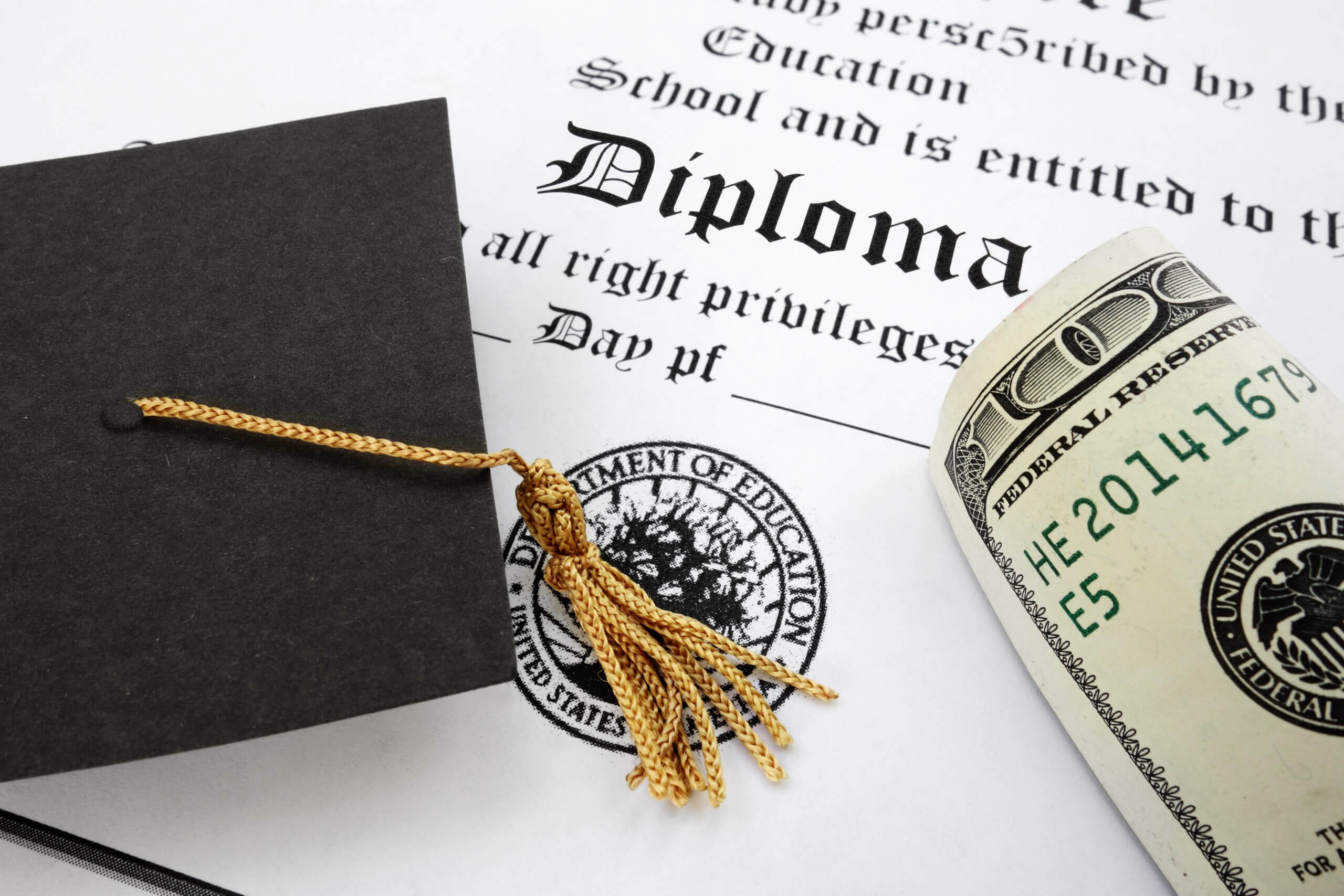The CARES Act has officially been signed into law. What does that mean for higher education institutions?
Education Stabilization Fund
- $30.75 billion total, less 2 percent for Indian Education, grants to governors in impacted areas and administrative expenses; or $30.135 billion, divided into three pools.
Sec. 18002. Governors (9.8 percent, or $2.953 billion)
- Allocated to states on basis of 60 percent of population ages 5-24 and 40 percent on population of children counted under
- Funds are not restricted to public institutions within the state.
- Imposes an maintenance of effort (MOE) on participating states that ties funding for the governors’ pool and the K-12 pool to an average of the past three years spending on K-12 and higher education for fiscal years 20-21.
- MOE doesn’t cover capital projects, R&D and tuition revenue.
- The Secretary may waive the MOE requirement for “states that have experienced a precipitous decline in financial resources.”
Sec. 18003. K-12 (43.9 percent or $13.229 billion)Sec. 18004. Higher Education (46.3 percent or $13.953 billion)
- Allocates 90 percent ($12.558 billion) directly to institutions through the Title IV distribution system.
- Institutional amounts are calculated using 75 percent of full-time equivalent enrollment of Pell students at an institution and 25 percent of the institutional award is calculated using full-time equivalent enrollment of non-Pell students.
- Students who were exclusively online are removed from the calculation.
- At least 50 percent of funds (or $6.279 billion) awarded to institutions must be used to provide direct emergency aid to students, including “grants to students for food, housing, course materi- als, technology, health care, and child care.”
- Allowable uses for the institutional portion of the funds are broad, and can be used to “defray expenses for institutions of higher education, such as lost revenue, technology costs associated with a transition to distance education.”
- Recipients of funds must retain current employees to the “maximum extent practicable.”
- Reserves 7.5 percent ($1.047 billion) for minority-serving institutions (MSI).
- Reserves 2.5 percent ($349 million) for grants to institutions particularly impacted by coronavirus, to be administered through
- Priority for these grants goes to smaller institutions who received less than $500,000 under the formula and MSI grants and still have significant unmet need.
Regulatory Flexibility
Sec. 3503. Campus-based aid waivers: Waives the requirements that institutions match federal funds and waives the limits on transferring funds between programs in the SEOG and FWS.
Sec. 3504. Use of supplemental educational opportunity grants (SEOG) for emergency aid: Allows institutions broad flexibility to disburse SEOG funding as emergency grant aid to students.
Sec. 3505. Federal work-study (FWS) during a qualifying emergency: Allows institutions to make FWS payments for students for a period of up to one year, even if the student is unable to perform the required work due to campus closures.
Sec. 3506. Adjustment of subsidized loan usage limits: Excludes loans borrowed from counting towards annual or cumulative limits if a borrower is unable to complete the term due to a qualifying emergency.
Sec. 3507. Exclusion from Federal Pell Grant duration limit: Excludes Pell Grants awarded from counting towards annual or cumulative limits if a Pell recipient is unable to complete the term due to a qualifying emergency.
Sec. 3508. Institutional refunds and Federal student loan flexibility: Suspends an institution’s obligation to return Title IV funds if a student withdraws during a payment period due to a qualifying emergency. Suspends a student’s obligation to return Title IV aid they have received if they withdraw during a payment period due to a qualifying emergency. Relieves borrowers of the obligation to repay loans that were taken out if they withdraw due to a qualifying emergency during the payment period those loans were borrowed for. Allows for institutions to allow students to take a leave of absence without needing to return in the same semester.
Sec. 3509. Satisfactory academic progress (SAP): Allows institutions to exclude terms impacted by a qualifying emergency in the calculation of a student SAP.
Sec. 3510. Continuing education at affected foreign institutions: Allows for otherwise eligible programs at foreign institutions to be eligible for Title IV aid for distance education.
Sec. 3512. HBCU Capital financing: Requires the Secretary to make principal and interest payments on these loans during a deferment period in which the institutions are not obligated to make any payments.
Sec. 3513. Temporary relief for federal student loan borrowers: Suspends borrowers’ obligation to make payments on their federal Direct Loans through September 2020; suspends interest on the payments; counts the suspended payments towards payment requirements for forgiveness provisions; suspends garnishment of wages, Social Security and tax refunds, among other measures, for borrowers in default during this period.
Sec. 3517. Waiver authority and reporting requirement for institutional aid: Authorizes the Secretary to waive certain statutory provisions regarding the distribution and uses of grant funding for minority-serving institutions, including graduate programs at HBCUs.
Sec. 3518. Authorized uses and other modifications for grants: Allows the Secretary to waive requirements regarding the allowable uses of grant funding and requirements on matching grants at the request of the institution.
Sec. 3519. Service obligations for teachers: Modifies the category of extenuating circumstances for the purposes of calculating a TEACH Grant recipient’s service obligation to include a qualifying emergency. Includes part-time or semester interrupted by a qualifying emergency towards a TEACH Grant recipient’s service obligation. Ensures that semesters of service interrupted by a qualifying emergency count towards consecutive years of service.
Tax Provisions
Delayed payment of payroll taxes:
- Employers, including public and private nonprofit institutions, are permitted to delay payment of FICA payroll taxes until Jan. 1, 2021. Employers who choose to delay payment of payroll taxes will have to repay 50 percent by Dec. 31, 2021, and the remaining 50 percent by Dec. 31, 2022.
Encourage More Charitable Giving:
- Temporary Universal charitable tax deduction. A temporary universal charitable tax deduction for donations of up to $300 per individual not itemizing his/her taxes.
- Temporary suspension of charitable contribution limits. The charitable tax deduction claimed by a taxpayer each tax year is generally limited to no more than 50 percent of the taxpayer’s adjusted gross income (AGI), unless a taxpayer gives only cash, in which case the limit increases to 60 percent of AGI. The bill will temporarily suspend the limitation for cash contributions in 2020 for which a taxpayer claims the charitable tax deduction.
Sec. 127–Expansion of Employer Provided Education Assistance to Student Loan Forgiveness:
- 127 employer provided education assistance expanded to include student loan repayment up to $5,250 per year made by an employer to the employee or to a lender of principal or interest on any qualified education loan as a tax-free benefit. To qualify, payments must be made before Jan 1, 2021
Employee Retention Credit for Employers Subject to Closure Due to COVID-19:
- The bill creates a refundable payroll tax credit of up to $5,000 for wages paid by employers to employees during the COVID-19 crisis. Employers whose operations were “fully or partially” suspended due to government orders related to COVID-19 are eligible for the credit. At this time, it appears that student workers would be covered employees.
- The credit is available to private nonprofit colleges and universities and to their related entities if they are organized as 501(c)(3)s. We believe this would include a range of organizations such as university foundations, research institutions, alumni organizations, university presses, etc. Employers that receive an Emergency Small Business Loan (SBA section 7(a)) are not eligible to receive the credit. Unfortunately, it appears that public institutions—if they or their related entities are deemed arms or subsidiaries of a state government—are ineligible.
- The bill does not define “partial” suspension. We think a reasonable interpretation of the provision would be that it applies to employees of offices, services or facilities (e.g. dining, dorms, athletic facilities) that have been “fully or partially” suspended would be covered but it would likely not cover for instance the faculty member who continues to teach on an online platform.
Dean Dorton is committed to higher education and helping guide institutions throughout this period. Please reach out to your Dean Dorton advisor or COVID19@deandorton.com for further questions or information.







